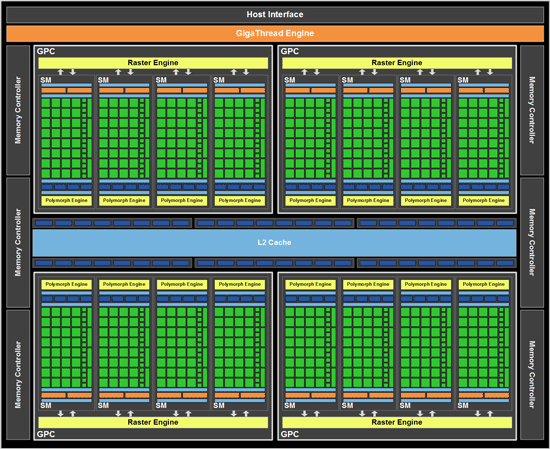NVIDIA's GeForce GTX 580: Fermi Refined
by Ryan Smith on November 9, 2010 9:00 AM ESTGF110: Fermi Learns Some New Tricks
We’ll start our in-depth look at the GTX 580 with a look at GF110, the new GPU at the heart of the card.
There have been rumors about GF110 for some time now, and while they ultimately weren’t very clear it was obvious NVIDIA would have to follow up GF100 with something else similar to it on 40nm to carry them through the rest of the processes’ lifecycle. So for some time now we’ve been speculating on what we might see with GF100’s follow-up part – an outright bigger chip was unlikely given GF100’s already large die size, but NVIDIA has a number of tricks they can use to optimize things.
Many of those tricks we’ve already seen in GF104, and had you asked us a month ago what we thought GF110 would be, we were expecting some kind of fusion of GF104 and GF100. Primarily our bet was on the 48 CUDA Core SM making its way over to a high-end part, bringing with it GF104’s higher theoretical performance and enhancements such as superscalar execution and additional special function and texture units for each SM. What we got wasn’t quite what we were imagining – GF110 is much more heavily rooted in GF100 than GF104, but that doesn’t mean NVIDIA hasn’t learned a trick or two.
Fundamentally GF110 is the same architecture as GF100, especially when it comes to compute. 512 CUDA Cores are divided up among 4 GPCs, and in turn each GPC contains 1 raster engine and 4 SMs. At the SM level each SM contains 32 CUDA cores, 16 load/store units, 4 special function units, 4 texture units, 2 warp schedulers with 1 dispatch unit each, 1 Polymorph unit (containing NVIDIA’s tessellator) and then the 48KB+16KB L1 cache, registers, and other glue that brought an SM together. At this level NVIDIA relies on TLP to keep a GF110 SM occupied with work. Attached to this are the ROPs and L2 cache, with 768KB of L2 cache serving as the guardian between the SMs and the 6 64bit memory controllers. Ultimately GF110’s compute performance per clock remains unchanged from GF100 – at least if we had a GF100 part with all of its SMs enabled.
On the graphics side however, NVIDIA has been hard at work. They did not port over GF104’s shader design, but they did port over GF104’s texture hardware. Previously with GF100, each unit could compute 1 texture address and fetch 4 32bit/INT8 texture samples per clock, 2 64bit/FP16 texture samples per clock, or 1 128bit/FP32 texture sample per clock. GF104’s texture units improved this to 4 samples/clock for 32bit and 64bit, and it’s these texture units that have been brought over for GF110. GF110 can now do 64bit/FP16 filtering at full speed versus half-speed on GF100, and this is the first of the two major steps NVIDIA took to increase GF110’s performance over GF100’s performance on a clock-for-clock basis.
| NVIDIA Texture Filtering Speed (Per Texture Unit) | |||||
| GF110 | GF104 | GF100 | |||
| 32bit (INT8) | 4 Texels/Clock | 4 Texels/Clock | 4 Texels/Clock | ||
| 64bit (FP16) | 4 Texels/Clock | 4 Texels/Clock | 2 Texels/Clock | ||
| 128bit (FP32) | 1 Texel/Clock | 1 Texel/Clock | 1 Texel/Clock | ||
Like most optimizations, the impact of this one is going to be felt more on newer games than older games. Games that make heavy use of 64bit/FP16 texturing stand to gain the most, while older games that rarely (if at all) used 64bit texturing will gain the least. Also note that while 64bit/FP16 texturing has been sped up, 64bit/FP16 rendering has not – the ROPs still need 2 cycles to digest 64bit/FP16 pixels, and 4 cycles to digest 128bit/FP32 pixels.
It’s also worth noting that this means that NVIDIA’s texture:compute ratio schism remains. Compared to GF100, GF104 doubled up on texture units while only increasing the shader count by 50%; the final result was that per SM 32 texels were processed to 96 instructions computed (seeing as how the shader clock is 2x the base clock), giving us 1:3 ratio. GF100 and GF110 on the other hand retain the 1:4 (16:64) ratio. Ultimately at equal clocks GF104 and GF110 widely differ in shading, but with 64 texture units total in both designs, both have equal texturing performance.
Moving on, GF110’s second trick is brand-new to GF110, and it goes hand-in-hand with NVIDIA’s focus on tessellation: improved Z-culling. As a quick refresher, Z-culling is a method of improving GPU performance by throwing out pixels that will never be seen early in the rendering process. By comparing the depth and transparency of a new pixel to existing pixels in the Z-buffer, it’s possible to determine whether that pixel will be seen or not; pixels that fall behind other opaque objects are discarded rather than rendered any further, saving on compute and memory resources. GPUs have had this feature for ages, and after a spurt of development early last decade under branded names such as HyperZ (AMD) and Lightspeed Memory Architecture (NVIDIA), Z-culling hasn’t been promoted in great detail since then.

Z-Culling In Action: Not Rendering What You Can't See
For GF110 this is changing somewhat as Z-culling is once again being brought back to the surface, although not with the zeal of past efforts. NVIDIA has improved the efficiency of the Z-cull units in their raster engine, allowing them to retire additional pixels that were not caught in the previous iteration of their Z-cull unit. Without getting too deep into details, internal rasterizing and Z-culling take place in groups of pixels called tiles; we don’t believe NVIDIA has reduced the size of their tiles (which Beyond3D estimates at 4x2); instead we believe NVIDIA has done something to better reject individual pixels within a tile. NVIDIA hasn’t come forth with too many details beyond the fact that their new Z-cull unit supports “finer resolution occluder tracking”, so this will have to remain a mystery for another day.
In any case, the importance of this improvement is that it’s particularly weighted towards small triangles, which are fairly rare in traditional rendering setups but can be extremely common with heavily tessellated images. Or in other words, improving their Z-cull unit primarily serves to improve their tessellation performance by allowing NVIDIA to better reject pixels on small triangles. This should offer some benefit even in games with fewer, larger triangles, but as framed by NVIDIA the benefit is likely less pronounced.
In the end these are probably the most aggressive changes NVIDIA could make in such a short period of time. Considering the GF110 project really only kicked off in earnest in February, NVIDIA only had around half a year to tinker with the design before it had to be taped out. As GPUs get larger and more complex, the amount of tweaking that can get done inside such a short window is going to continue to shrink – and this is a far cry from the days where we used to get major GPU refreshes inside of a year.











160 Comments
View All Comments
Sihastru - Tuesday, November 9, 2010 - link
At this point it makes no sense to get rattled up about the 580. We must patiently wait for the 69x0 cards and see what they can bring to the table. I heard rumours of AMD delaying their cards to the end of the year in order to do some "tweaks"...nitrousoxide - Tuesday, November 9, 2010 - link
Delaying is something good because it indicates that Cayman can be very big, very fast and...very hungry making it hard to build. What AMD needs is a card that can defeat GTX580, no matter how hot or power-hungry it is.GeorgeH - Tuesday, November 9, 2010 - link
Is there any word on a fully functional GF104?Nvidia could call it the 560, with 5="Not Gimped".
Sihastru - Tuesday, November 9, 2010 - link
I guess once GTX470 goes EOL. If GTX460 had all it's shaders enabled then the overclocked versions would have canibalized GTX470 sales. Even so, it will happen on occasion.tomoyo - Tuesday, November 9, 2010 - link
My guess is there will be GTX 580 derivatives with less cores enabled as usual, probably a GTX 570 or something. And then an improved GTX 460 with all cores enabled as the GTX 560.tomoyo - Tuesday, November 9, 2010 - link
Good to see nvidia made a noticeable improvement over the overly hot and power hungry GTX 480. Unfortunately way above my power and silence needs, but competition is a good thing. Now I'm highly curious how close the Radeon 69xx will come in performance or if it can actually beat the GTX 580 in some cases.Of course the GTX 480 is completely obsolete now, more power, less speed, more noise, ugly to look at.
7eki - Tuesday, November 9, 2010 - link
What we got here today is a higher clocked, better cooled GTX 480 with a slightly better power consumption. All of that for only 80$ MORE ! Any first served version of non referent GTX 480 is equipped with a much better cooling solution that gives higher OC possibilites and could kick GTX 580's ass. If we compare GTX 480 to a GTX580 clock2clock we will get about 3% of a difference in performance. All thanks to 32 CUDA processors, and a few more TMU's. How come the reviewers are NOW able to find pros of something that they used to criticise 7 months ago ? Don't forget that AMD's about to break their Sweet Spot strategy just to cut your hypocrites tongues. I bet that 6990's going to be twice as fast as what we got here today . If we really got anything cause I can't really tell the difference.AnnonymousCoward - Tuesday, November 9, 2010 - link
32W less for 15% more performance, still on 40nm, is a big deal.7eki - Wednesday, November 10, 2010 - link
32W and 15% you say ? No it isn't a big deal since AMD's Barts GPUs release. Have on mind that GTX580 still consumes more energy than a faster (in most cases) and one year older multi GPU HD5970. In that case even 60 would sound ridiculosly funny. It's not more than a few percent improvement over GTX480. If you don't believe it calculate how much longer will you have to play on your GTX580 just to get your ~$40 spent on power consumption compared to a GTX480 back. Not to mention (again) that a nonreferent GTX480 provides much better cooling solutions and OC possibilities. Nvidia's diggin their own grave. Just like they did by releasing GTX460. The only thing that's left for them right now is to trick the reviewers. But who cares. GTX 580 isn't going to make them sell more mainstream GPUs. It isn't nvidia whos cutting HD5970 prices right now. It was AMD by releasing HD6870/50 and announcing 6970. It should have been mentioned by all of you reviewers who treat the case seriously. Nvidia's a treacherous snake and the reviewers job is not to let such things happen.Sihastru - Wednesday, November 10, 2010 - link
Have you heard about the ASUS GTX580 Voltage Tweak edition that can be clocked up to 1100 MHz, that's more then 40% OC? Have you seen the EVGA GTX580 FTW yet?The fact that a single GPU card is in some cases faster then a dual GPU card built with two of the fastest competing GPU's tells a lot of good things about that single GPU card.
This "nVidia in the Antichrist" speech is getting old. Repeating it all over the interwebs doesn't make it true.